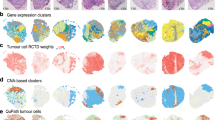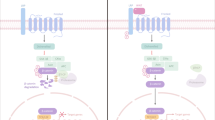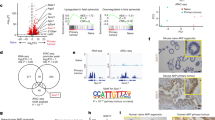Abstract
In a significant fraction of breast cancer patients, distant metastases emerge after years or even decades of latency. How disseminated tumour cells (DTCs) are kept dormant, and what wakes them up, are fundamental problems in tumour biology. To address these questions, we used metastasis assays in mice and showed that dormant DTCs reside on microvasculature of lung, bone marrow and brain. We then engineered organotypic microvascular niches to determine whether endothelial cells directly influence breast cancer cell (BCC) growth. These models demonstrated that endothelial-derived thrombospondin-1 induces sustained BCC quiescence. This suppressive cue was lost in sprouting neovasculature; time-lapse analysis showed that sprouting vessels not only permit, but accelerate BCC outgrowth. We confirmed this surprising result in dormancy models and in zebrafish, and identified active TGF-β1 and periostin as tumour-promoting factors derived from endothelial tip cells. Our work reveals that stable microvasculature constitutes a dormant niche, whereas sprouting neovasculature sparks micrometastatic outgrowth.
This is a preview of subscription content, access via your institution
Access options
Subscribe to this journal
Receive 12 print issues and online access
$209.00 per year
only $17.42 per issue
Buy this article
- Purchase on Springer Link
- Instant access to full article PDF
Prices may be subject to local taxes which are calculated during checkout







Similar content being viewed by others
References
Aguirre-Ghiso, J. A. Models, mechanisms and clinical evidence for cancer dormancy. Nat. Rev. Cancer 7, 834–846 (2007).
Goss, P. E. & Chambers, A. F. Does tumour dormancy offer a therapeutic target? Nat. Rev. Cancer 10, 871–877 (2010).
Klein, C. A. Parallel progression of primary tumours and metastases. Nat. Rev. Cancer 9, 302–312 (2009).
Uhr, J. W. & Pantel, K. Controversies in clinical cancer dormancy. Proc. Natl Acad. Sci. USA 108, 12396–12400 (2011).
Kaplan, R. N. et al. VEGFR1-positive haematopoietic bone marrow progenitors initiate the pre-metastatic niche. Nature 438, 820–827 (2005).
Peinado, H. et al. Melanoma exosomes educate bone marrow progenitor cells toward a pro-metastatic phenotype through MET. Nat. Med. 18, 883–891 (2012).
Psaila, B. & Lyden, D. The metastatic niche: adapting the foreign soil. Nat. Rev. Cancer 9, 285–293 (2009).
Suzuki, M., Mose, E. S., Montel, V. & Tarin, D. Dormant cancer cells retrieved from metastasis-free organs regain tumorigenic and metastatic potency. Am. J. Pathol. 169, 673–681 (2006).
Naumov, G. N. et al. Persistence of solitary mammary carcinoma cells in a secondary site: a possible contributor to dormancy. Cancer Res. 62, 2162–2168 (2002).
Pantel, K. et al. Differential expression of proliferation-associated molecules in individual micrometastatic carcinoma cells. J. Natl. Cancer Inst. 85, 1419–1424 (1993).
Bissell, M. J. & Hines, W. C. Why don’t we get more cancer? A proposed role of the microenvironment in restraining cancer progression. Nat. Med. 17, 320–329 (2011).
Boudreau, N., Sympson, C. J., Werb, Z. & Bissell, M. J. Suppression of ICE and apoptosis in mammary epithelial cells by extracellular matrix. Science 267, 891–893 (1995).
Spencer, V. A. et al. Depletion of nuclear actin is a key mediator of quiescence in epithelial cells. J. Cell Sci. 124, 123–132 (2011).
Weaver, V. M. et al. β4 integrin-dependent formation of polarized three-dimensional architecture confers resistance to apoptosis in normal and malignant mammary epithelium. Cancer Cell 2, 205–216 (2002).
Weaver, V. M. et al. Reversion of the malignant phenotype of human breast cells in three-dimensional culture and in vivo by integrin blocking antibodies. J. Cell Biol. 137, 231–245 (1997).
Bissell, M. J., Hall, H. G. & Parry, G. How does the extracellular matrix direct gene expression? J. Theor. Biol. 99, 31–68 (1982).
Petersen, O. W., Ronnov-Jessen, L., Howlett, A. R. & Bissell, M. J. Interaction with basement membrane serves to rapidly distinguish growth and differentiation pattern of normal and malignant human breast epithelial cells. Proc. Natl Acad. Sci. USA 89, 9064–9068 (1992).
Braun, S. et al. A pooled analysis of bone marrow micrometastasis in breast cancer. New Engl. J. Med. 353, 793–802 (2005).
Chambers, A. F., Groom, A. C. & MacDonald, I. C. Dissemination and growth of cancer cells in metastatic sites. Nat. Rev. Cancer 2, 563–572 (2002).
Francia, G., Cruz-Munoz, W., Man, S., Xu, P. & Kerbel, R. S. Mouse models of advanced spontaneous metastasis for experimental therapeutics. Nat. Rev. Cancer 11, 135–141 (2011).
Paget, S. The distribution of secondary growths in cancer of the breast. Cancer Metast. Rev. 8, 98–101 (1989).
Briand, P., Nielsen, K. V., Madsen, M. W. & Petersen, O. W. Trisomy 7p and malignant transformation of human breast epithelial cells following epidermal growth factor withdrawal. Cancer Res. 56, 2039–2044 (1996).
Butler, J. M. et al. Endothelial cells are essential for the self-renewal and repopulation of Notch-dependent hematopoietic stem cells. Cell Stem Cell 6, 251–264 (2010).
Seandel, M. et al. Generation of a functional and durable vascular nicheby the adenoviral E4ORF1 gene. Proc. Natl Acad. Sci. USA 105, 19288–19293 (2008).
Butler, J. M., Kobayashi, H. & Rafii, S. Instructive role of the vascular niche in promoting tumour growth and tissue repair by angiocrine factors. Nat. Rev. Cancer 10, 138–146 (2010).
Evensen, L. et al. Mural cell associated VEGF is required for organotypic vessel formation. PLoS ONE 4, e5798 (2009).
Weinstat-Saslow, D. L. et al. Transfection of thrombospondin 1 complementary DNA into a human breast carcinoma cell line reduces primary tumor growth, metastatic potential, and angiogenesis. Cancer Res. 54, 6504–6511 (1994).
Roberts, D. D. Regulation of tumor growth and metastasis by thrombospondin-1. FASEB J. 10, 1183–1191 (1996).
Ghajar, C. M. et al. The effect of matrix density on the regulation of 3-D capillary morphogenesis. Biophys. J. 94, 1930–1941 (2008).
Hellstrom, M. et al. Dll4 signalling through Notch1 regulates formation of tip cells during angiogenesis. Nature 445, 776–780 (2007).
Avraham-Davidi, I. et al. ApoB-containing lipoproteins regulate angiogenesis by modulating expression of VEGF receptor 1. Nat. Med. 18, 967–973 (2012).
Kim, S. et al. Carcinoma-produced factors activate myeloid cells through TLR2 to stimulate metastasis. Nature 457, 102–106 (2009).
Malanchi, I. et al. Interactions between cancer stem cells and their niche govern metastatic colonization. Nature 481, 85–89 (2012).
Oskarsson, T. et al. Breast cancer cells produce tenascin C as a metastatic niche component to colonize the lungs. Nat. Med. 17, 867–874 (2011).
Soikkeli, J. et al. Metastatic outgrowth encompasses COL-I, FN1, and POSTN up-regulation and assembly to fibrillar networks regulating cell adhesion, migration, and growth. Am. J. Pathol. 177, 387–403 (2010).
Bierie, B. & Moses, H. L. Tumour microenvironment: TGFβ: the molecular Jekyll and Hyde of cancer. Nat. Rev. Cancer 6, 506–520 (2006).
Matsumoto, K., Yoshitomi, H., Rossant, J. & Zaret, K. S. Liver organogenesis promoted by endothelial cells prior to vascular function. Science 294, 559–563 (2001).
Ding, B. S. et al. Endothelial-derived angiocrine signals induce and sustain regenerative lung alveolarization. Cell 147, 539–553 (2011).
Lammert, E., Cleaver, O. & Melton, D. Induction of pancreatic differentiation by signals from blood vessels. Science 294, 564–567 (2001).
Dodge, A. B., Lu, X. & D’Amore, P. A. Density-dependent endothelial cell production of an inhibitor of smooth muscle cell growth. J. Cell Biochem. 53, 21–31 (1993).
Crisan, M. et al. A perivascular origin for mesenchymal stem cells in multiple human organs. Cell Stem Cell 3, 301–313 (2008).
Kobayashi, H. et al. Angiocrine factors from Akt-activated endothelial cells balance self-renewal and differentiation of haematopoietic stem cells. Nat. Cell Biol. 12, 1046–1056 (2010).
Shen, Q. et al. Endothelial cells stimulate self-renewal and expand neurogenesis of neural stem cells. Science 304, 1338–1340 (2004).
Ding, L., Saunders, T. L., Enikolopov, G. & Morrison, S. J. Endothelial and perivascular cells maintain haematopoietic stem cells. Nature 481, 457–462 (2012).
Bandyopadhyay, S. et al. Interaction of KAI1 on tumor cells with DARC on vascular endothelium leads to metastasis suppression. Nat. Med. 12, 933–938 (2006).
Calabrese, C. et al. A perivascular niche for brain tumor stem cells. Cancer Cell 11, 69–82 (2007).
Franses, J. W., Baker, A. B., Chitalia, V. C. & Edelman, E. R. Stromal endothelial cells directly influence cancer progression. Sci. Trans. Med. 3, 66ra65 (2011).
Indraccolo, S. et al. Cross-talk between tumor and endothelial cells involving the Notch3-Dll4 interaction marks escape from tumor dormancy. Cancer Res. 69, 1314–1323 (2009).
Panigrahy, D. et al. Epoxyeicosanoids stimulate multiorgan metastasis and tumor dormancy escape in mice. J. Clin. Invest. 122, 178–191 (2012).
Asosingh, K. et al. Nascent endothelium initiates th2 polarization of asthma. J. Immunol. 190, 3458–3465 (2013).
Lin, E. Y., Nguyen, A. V., Russell, R. G. & Pollard, J. W. Colony-stimulating factor 1 promotes progression of mammary tumors to malignancy. J. Exp. Med. 193, 727–740 (2001).
Qian, B. Z. & Pollard, J. W. Macrophage diversity enhances tumor progression and metastasis. Cell 141, 39–51 (2010).
DeNardo, D. G. et al. CD4(+) T cells regulate pulmonary metastasis of mammary carcinomas by enhancing protumor properties of macrophages. Cancer Cell 16, 91–102 (2009).
Folkman, J. Angiogenesis: an organizing principle for drug discovery? Nat. Rev. Drug Discov. 6, 273–286 (2007).
Jakobsson, L. et al. Endothelial cells dynamically compete for the tip cell position during angiogenic sprouting. Nat. Cell Biol. 12, 943–953 (2010).
Brooks, P. C., Clark, R. A. & Cheresh, D. A. Requirement of vascular integrin αvβ3 for angiogenesis. Science 264, 569–571 (1994).
Stratman, A. N., Davis, M. J. & Davis, G. E. VEGF and FGF prime vascular tube morphogenesis and sprouting directed by hematopoietic stem cell cytokines. Blood 117, 3709–3719 (2011).
Lee, G. Y., Kenny, P. A., Lee, E. H. & Bissell, M. J. Three-dimensional culture models of normal and malignant breast epithelial cells. Nat. Meth. 4, 359–365 (2007).
Pitulescu, M. E., Schmidt, I., Benedito, R. & Adams, R. H. Inducible gene targeting in the neonatal vasculature and analysis of retinal angiogenesis in mice. Nat. Protoc. 5, 1518–1534 (2010).
Herbert, S. P. et al. Arterial-venous segregation by selective cell sprouting: an alternative mode of blood vessel formation. Science 326, 294–298 (2009).
Nicoli, S. & Presta, M. The zebrafish/tumor xenograft angiogenesis assay. Nat. Protoc. 2, 2918–2923 (2007).
Baluk, P., Morikawa, S., Haskell, A., Mancuso, M. & McDonald, D. M. Abnormalities of basement membrane on blood vessels and endothelial sprouts in tumors. Am. J. Pathol. 163, 1801–1815 (2003).
Tanner, K., Mori, H., Mroue, R., Bruni-Cardoso, A. & Bissell, M. J. Coherent angular motion in the establishment of multicellular architecture of glandular tissues. Proc. Natl Acad. Sci. USA 109, 1973–1978 (2012).
Beliveau, A. et al. Raf-induced MMP9 disrupts tissue architecture of human breast cells in three-dimensional culture and is necessary for tumor growth in vivo. Genes Dev. 24, 2800–2811 (2010).
Acknowledgements
We thank S. Rafii and B. Weinstein for generously providing the E4ORF1 lentiviral plasmid and stalactite mutant zebrafish, respectively. We are grateful to N. Boudreau, S. Rafii, R. Schwartz, R. Xu, A. Bruni-Cardoso and A.L. Correia for critical insight, and to other present members of the Bissell laboratory for helpful discussions. We thank A. Lo and C. Williams for technical assistance and T. Varimezova for performing blinded quantitative analysis. C.M.G. was financially supported by a Glenn T. Seaborg Postdoctoral Fellowship from LBNL and by a NCI-U54CA143836 training grant. K.J.E. is a Robert Black Fellow supported by the Damon Runyon Cancer Research Foundation (DRG-109-10). K.A.H.’s laboratory is supported by grants from the NIH (R01HL042493 and R01HL090895) and from the March of Dimes Foundation (6-FY12-356). The work in D.Y.R.S.’s laboratory was financially supported in part by grants from the NIH (HL54737) and the Packard Foundation. E.I.C.’s laboratory is supported by a Carol Baldwin Breast Cancer Award, a shared instrument grant (NIH/NCRR 1 S10 RR023680-1) and a DOE Subcontract (DE-AC02-05CH1123) from LBNL. D.L. is supported by The Hartwell Foundation. The work from M.J.B.’s laboratory is supported by grants from the US Department of Energy, Office of Biological and Environmental Research and Low Dose Scientific Focus Area (contract no. DE-AC02-05CH1123); by the National Cancer Institute (awards U01CA169538 (to D.L. and M.J.B.), U54CA126552, R37CA064786 and U54CA143836—Bay Area Physical Sciences–Oncology Center, University of California, Berkeley, California); by a grant from the Breast Cancer Research Foundation; and by the US Department of Defense (W81XWH0810736).
Author information
Authors and Affiliations
Contributions
C.M.G., D.L. and M.J.B. conceived of the study. C.M.G., H.P., I.R.M. and H.B. conducted animal studies and analysed resulting data. C.M.G., K.J.E. and D.Y.R.S. planned and executed zebrafish experiments. D.A. and K.A.H. lent expertise in the retinal neovascularization model. C.M.G. and H.M. collected and analysed data, and H.M. also provided conceptual advice. A.K. and E.I.C. conducted LC–MS/MS analysis and analysed data. C.M.G. and M.J.B. wrote the manuscript. All authors read and critiqued the manuscript extensively.
Corresponding authors
Ethics declarations
Competing interests
The authors declare no competing financial interests.
Supplementary information
Supplementary Information
Supplementary Information (PDF 1466 kb)
Opposite regulation of tumour quiescence and growth by endothelial sub-niches: stable endothelium inhibits breast tumour cell growth.
H2B-GFP T4-2 cells residing predominantly around stable endothelium does not undergo division over a 72 h period. Intervals, 20 min. Scale bar, 50 μm. (MOV 4280 kb)
Opposite regulation of tumour quiescence and growth by endothelial sub-niches: neovascular tips promote breast tumour cell growth.
H2B-GFP T4-2 cells are observed dividing soon after encountering neovascular tips. Highlighted cell divides after encountering an endothelial ‘probe’. At the right of the screen, another cell divides at 1 d, 16:00, as it encounters an approaching neovascular tip. One of the daughter cells divides again as the couplet resumes interaction with the tip. At the bottom, another cell ‘surfs’ past a neovascular tip and eventually divides. Intervals, 20 min. Scale bar, 100 μm. (MOV 4219 kb)
Rights and permissions
About this article
Cite this article
Ghajar, C., Peinado, H., Mori, H. et al. The perivascular niche regulates breast tumour dormancy. Nat Cell Biol 15, 807–817 (2013). https://doi.org/10.1038/ncb2767
Received:
Accepted:
Published:
Issue Date:
DOI: https://doi.org/10.1038/ncb2767
This article is cited by
-
Glucocorticoid receptor: a harmonizer of cellular plasticity in breast cancer—directs the road towards therapy resistance, metastatic progression and recurrence
Cancer and Metastasis Reviews (2024)
-
Tumor-derived cell-free DNA and circulating tumor cells: partners or rivals in metastasis formation?
Clinical and Experimental Medicine (2024)
-
Plasma THBS1 as a predictive biomarker for poor prognosis and brain metastasis in patients with HER2-enriched breast cancer
International Journal of Clinical Oncology (2024)
-
Predictive and prognostic biomarkers of bone metastasis in breast cancer: current status and future directions
Cell & Bioscience (2023)
-
Age-associated microenvironmental changes highlight the role of PDGF-C in ER+ breast cancer metastatic relapse
Nature Cancer (2023)



